

Moving Between the Specific and Abstract. When differentiating a lesson, let’s think about where our content lands on the spectrum of abstraction.
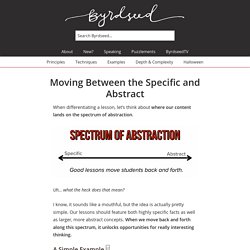
Uh… what the heck does that mean? I know, it sounds like a mouthful, but the idea is actually pretty simple. Our lessons should feature both highly specific facts as well as larger, more abstract concepts. When we move back and forth along this spectrum, it unlocks opportunities for really interesting thinking. A Simple Example 🚘 Here’s a spectrum of abstraction starting with my own car. My 2008 Kia Rondo (most specific)2008 Kia RondosKia Rondos Cars made by KiaCarsVehiclesTransportationSystems (most abstract) My car is a highly specific example. To move towards the abstract end of the spectrum, we can ask: Examples – Byrdseed. Which One Is Not Like The Others. All About Asking Better Questions.
Asking questions is such a basic tool of teaching, yet how many of us have ever been taught to ask good questions?
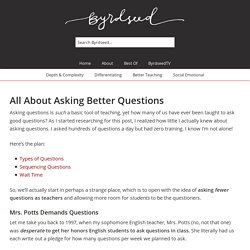
As I started researching for this post, I realized how little I actually knew about asking questions. I asked hundreds of questions a day but had zero training. I know I’m not alone! Here’s the plan: So, we’ll actually start in perhaps a strange place, which is to open with the idea of asking fewer questions as teachers and allowing more room for students to be the questioners. Mrs. Let me take you back to 1997, when my sophomore English teacher, Mrs.
4 Types of Questions To Ask Gifted Kids. 10 Metacognitive Prompts To Help Students Reflect On Their Learning - By TeachThought Staff & Peter Pappas It’s well-established that reflection is critical in the learning process.
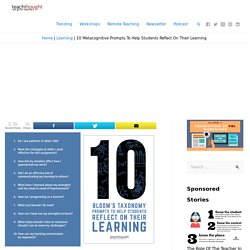
While it sounds formal, ‘reflection’ simply means to ‘think again’ about something that happened. (37) 60-Second Strategies. Queensland Curriculum and Assessment Authority. Thinking or Remembering? How To Introduce Depth and Complexity. 10 Team-Building Games That Promote Critical Thinking. Via TeachThought One of education’s primary goals is to groom the next generation of little humans to succeed in the “real world.”

Yes, there are mounds of curricula they must master in a wide breadth of subjects, but education does not begin and end with a textbook or test. Listening Comprehension, Listening that sparks learning. Edutopia. 7 Ways to Inspire Divergent Thinking in the Classroom. The world is unpredictable.
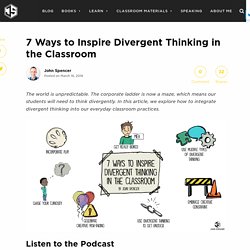
The corporate ladder is now a maze, which means our students will need to think divergently. In this article, we explore how to integrate divergent thinking into our everyday classroom practices. If you enjoy this blog but you’d like to listen to it on the go, just click on the audio below or subscribe via iTunes/Apple Podcasts (ideal for iOS users) or Google Play and Stitcher (ideal for Android users). When I was a kid, my twin brother and I loved watching American Gladiators. Common Core in Action: 10 Visual Literacy Strategies. Do you wish your students could better understand and critique the images that saturate their waking life?
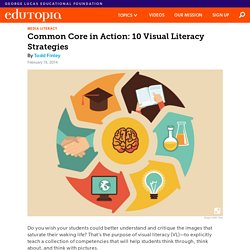
That’s the purpose of visual literacy (VL)—to explicitly teach a collection of competencies that will help students think through, think about, and think with pictures. Standards Support Visual Literacy Instruction Visual literacy is a staple of 21st century skills, the idea that learners today must “demonstrate the ability to interpret, recognize, appreciate, and understand information presented through visible actions, objects, and symbols, natural or man-made.” Putting aside the imperative to teach students how to create meaningful images, the ability to read images is reflected in the following standards. Common Core State Standards. The Great Question Press. Why should teachers nurture potent questioning skills and behaviors?
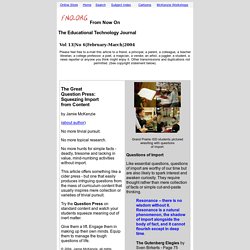
As a practical matter, students need to be able to read between the lines, infer meaning, draw conclusions from disparate clues and avoid the traps of presumptive intelligence, bias and predisposition. They need these thinking skills to score well on increasingly tough school tests, but more importantly, they need these skills to score well on the increasingly baffling tests of life . . . how to vote? Useful Tips on Writing Essential Questions. Written by: Keren Perles • edited by: Wendy Finn • updated: 9/11/2012 Essential questions can make the lesson planning process more effective, but many teachers struggle to write quality essential questions for their lessons.
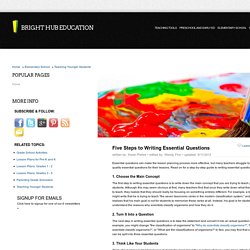
Read on for a step-by-step guide to writing essential questions. 1. Choose the Main ConceptThe first step to writing essential questions is to write down the main concept that you are trying to teach your students. Engage, Expand and Encompass Through Technology. Engage, Expand and Encompass Through Technology. Race and the Literary Canon. “OK,” I say to my students, “this is a book written 57 years ago about events that would have happened 84 years ago. Are the things being discussed here still relevant today? Why or why not?” My students pause. We’ve just finished reading To Kill a Mockingbird, a novel their parents probably read as well at some point. In many ways, the book feels far removed from my students when they first pick it up. Edutopia. Challenging students to dig in and achieve their potential during instructional hours confronts a mighty obstacle: the principle of least effort, the idea that people apply nominal effort to achieve a basically acceptable result instead of pushing themselves in pursuit of greatness.
We might be tempted to conflate low effort with laziness, but that misses an important physiological point: To conserve finite attention funds, our brains are designed to avoid tasks that are cognitively demanding. Daniel Kahneman, author of Thinking, Fast and Slow, describes two modes of thinking. 48 Critical Thinking Questions For Any Content Area - 10 tips for talking about news, politics and current events in schools. In schools everywhere, students are deeply affected by current events.

Certain policy changes and related commentary can cause children to experience fear, confusion and anxiety. For example, some kids might fear deportation. Others might be upset about hurtful generalizations they hear regarding their cultures and countries of origin. A lot of kids might fear the loss of rights. Teachers around the world have shared that having conversations about these topics is challenging, and sometimes they end up avoiding these conversations altogether. Using Webb's Depth of Knowledge to Increase Rigor. Calculating Cognitive Depth For classroom teachers, the more important question is one of practice: How do we create rich environments where all students learn at a high level?
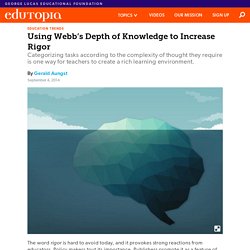
One useful tool, Norman Webb’s Depth of Knowledge Levels, can help teachers meet that challenge. Edutopia. Public Library of Critical Thinking Resources. Questioning Strategies — Verso Learning. Questioning Toolkit. Essential Questions. Rediquest - Home. Teaching strategies. Global education covers complex and controversial issues. This is a selection of teaching and learning approaches that develop knowledge and skills to respond to global issues.
10 Team-Building Games That Promote Collaborative Critical Thinking. What Are 21st-Century Skills? Learning to collaborate with others and connect through technology are essential skills in a knowledge-based economy. Blooms, learning styles and thinking organisers. How do thinking/graphical organisers or mind mapping tools fit with Learning styles and Bloom's Revised taxonomy. Bloom's and the Three Storey Intellect.
A colleague has given me an excellent poster she has developed on the three storey intellect. As a taxonomy of higher and lower order thinking, it is a clean and simple model. The three storey intellect was inspired Oliver Wendell Holmes.